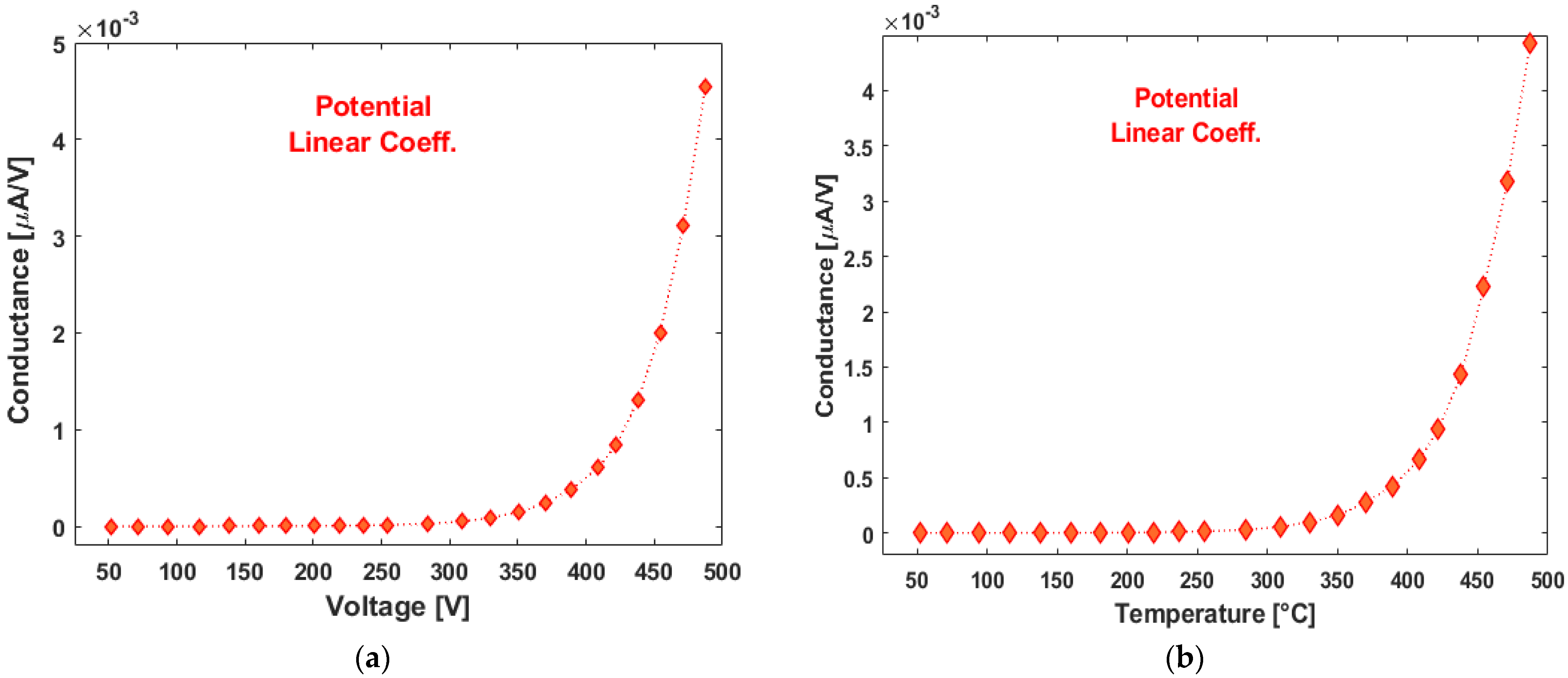Frenkel-Poole Mechanism Unveils Black Diamond as Quasi-Epsilon-Near-Zero Surface
Abstract
1. Introduction
2. Materials and Methods
3. Results
3.1. Morphological and Chemical Characterization
- The εr change is supposed to be almost 2D. Therefore, it is unable to significantly contribute to the overall laser-diamond substrate interaction of the second texturing.
- The first treatment is performed at half of the standard power to produce a high-quality black-diamond surface. Therefore, the superficial εr change is also limited in value.
- The εr reduction is further enhanced by the two-stage texturing due to the incubation effect (see Appendix B).
3.2. Electrical Measurements
- A.
- A Linear Fitting (I = AOffset + GLin*V), excluding point acquired at voltages > 100 V (red lines), where AOffset is the little initial bias error of the instrument and GLin is the overall conductance of the sample at low voltages.
- B.
- A First Exponential Fitting (I = G1FP*V*exp(β1√V)), excluding the point acquired at voltages > 230 V (blue lines), where G1FP represents the sample linear conductance to be combined with the exponential contribution and β1 represents the FP coefficient divided by the contact distance square root.
- C.
- A Second Exponential Fitting (I = G2FP*V*exp(β2√V)), considering all the experimental points (green lines), where G2FP and β2 have the same meaning of G1FP and β1.
4. Discussion
5. Conclusions
Author Contributions
Funding
Data Availability Statement
Acknowledgments
Conflicts of Interest
Appendix A. Opposite Direction Voltage Ramp Measurements

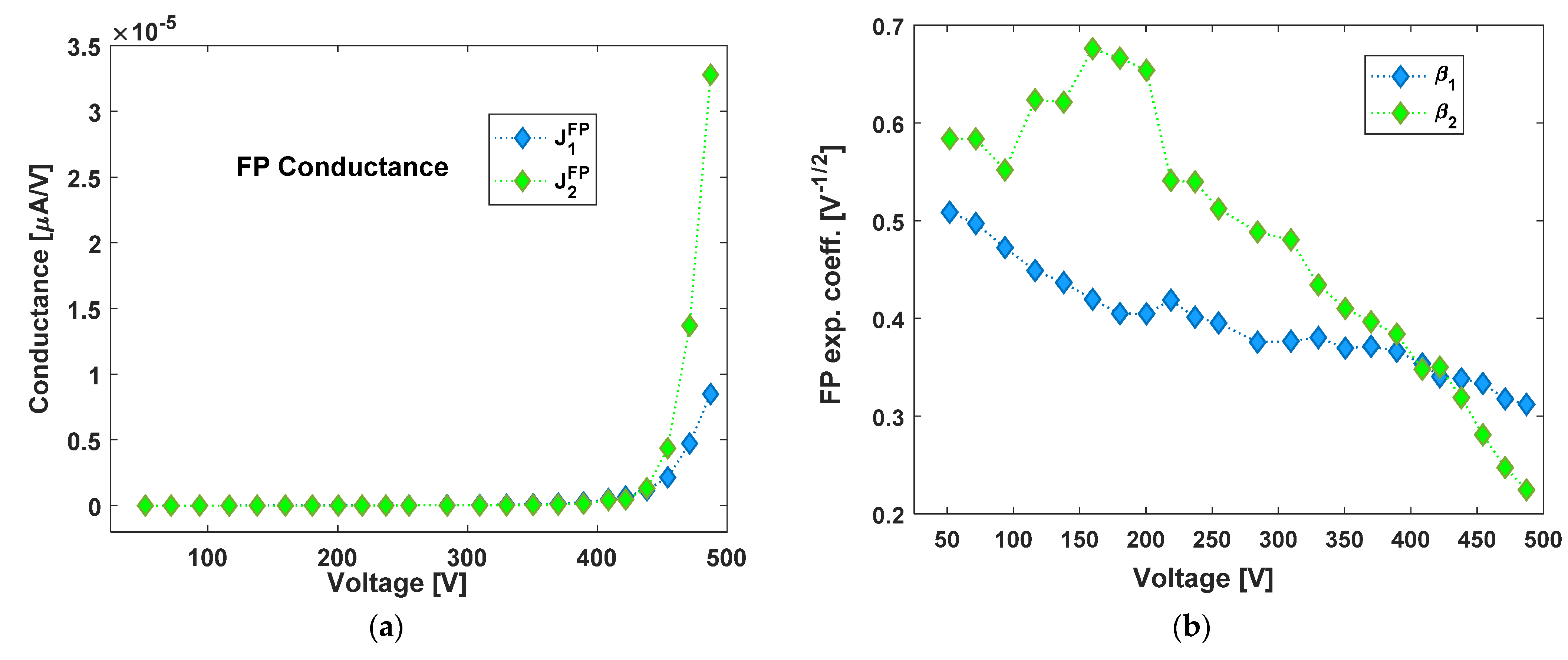
Appendix B. Analysis of Black-Diamond Sample with Reduced Total Accumulated Laser Fluence
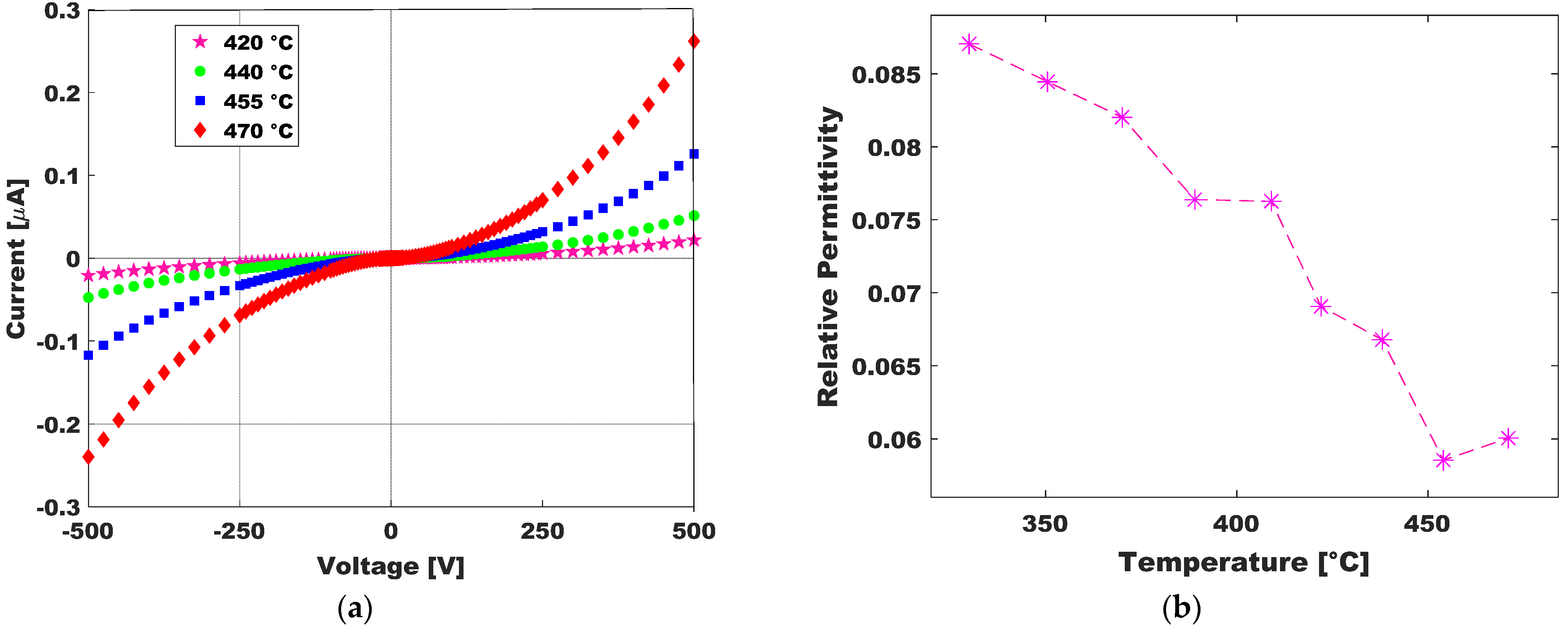
References
- Calvani, P.; Bellucci, A.; Girolami, M.; Orlando, S.; Valentini, V.; Lettino, A.; Trucchi, D.M. Optical properties of femtosecond laser-treated diamond. Appl. Phys. A Mater. Sci. Proc. 2014, 117, 25–29. [Google Scholar] [CrossRef]
- Girolami, M.; Bellucci, A.; Calvani, P.; Trucchi, D.M. Large single-crystal diamond substrates for ionizing radiation detection. Phys. Status Solidi 2016, 213, 2634–2640. [Google Scholar] [CrossRef]
- Trucchi, D.M.; Melosh, N.A. Electron-emission materials: Advances, applications, and models. MRS Bull. 2017, 42, 488–492. [Google Scholar] [CrossRef]
- Girolami, M.; Bellucci, A.; Mastellone, M.; Orlando, S.; Orsini, A.; Salvatori, S.; Trucchi, D.M. Transport properties of photogenerated charge carriers in black diamond films. Ceram. Int. 2018, 45, 9544–9547. [Google Scholar] [CrossRef]
- Trucchi, D.M.; Bellucci, A.; Girolami, M.; Calvani, P.; Cappelli, E.; Orlando, S.; Polini, R.; Silvestroni, L.; Sciti, D.; Kribus, A. Solar Thermionic-Thermoelectric Generator (ST2G): Concept, Materials Engineering, and Prototype Demonstration. Adv. Energy Mater. 2018, 8, 1–14. [Google Scholar] [CrossRef]
- Granados, E.; Martinez-Calderon, M.; Gomez, M.; Rodriguez, A.; Olaizola, S.M. Photonic structures in diamond based on femtosecond UV laser induced periodic surface structuring (LIPSS). Opt. Express 2017, 25, 15330. [Google Scholar] [CrossRef]
- Martínez-Calderon, M.; Azkona, J.J.; Casquero, N.; Rodríguez, A.; Domke, M.; Gómez-Aranzadi, M.; Olaizola, S.M.; Granados, E. Tailoring diamond’s optical properties via direct femtosecond laser nanostructuring. Sci. Rep. 2018, 8, 14262. [Google Scholar] [CrossRef]
- Salvatori, S.; Rossi, M.C.; Conte, G.; Kononenko, T.; Komlenok, M.; Khomich, A.; Ralchenko, V.; Konov, V.; Provatas, G.; Jaksic, M. Diamond Detector with Laser-Formed Buried Graphitic Electrodes: Micron-Scale Mapping of Stress and Charge Collection Efficiency. IEEE Sens. J. 2019, 19, 11908–11917. [Google Scholar] [CrossRef]
- Khomich, A.A.; Ashikkalieva, K.K.; Bolshakov, A.P.; Kononenko, T.V.; Ralchenko, V.G.; Konov, V.I.; Oliva, P.; Conte, G.; Salvatori, S. Very long laser-induced graphitic pillars buried in single-crystal CVD-diamond for 3D detectors realization. Diam. Relat. Mater. 2018, 90, 84–92. [Google Scholar] [CrossRef]
- Girolami, M.; Bellucci, A.; Mastellone, M.; Orlando, S.; Valentini, V.; Montereali, R.M.; Vincenti, M.A.; Polini, R.; Trucchi, D.M. Optical characterization of double-nanotextured black diamond films. Carbon N. Y. 2018, 138, 384–389. [Google Scholar] [CrossRef]
- Orsini, A.; Bellucci, A.; Girolami, M.; Mastellone, M.; Orlando, S.; Prestopino, G.; Valentini, V.; Salvatori, S.; Trucchi, D.M. Electrical conductivity of double textured black diamond films from RT to 800 K. Diam. Relat. Mater. 2019, 93, 1–7. [Google Scholar] [CrossRef]
- Orsini, A.; Barettin, D.; Ercoli, F.; Rossi, M.C.; Pettinato, S.; Salvatori, S.; Mezzi, A.; Polini, R.; Bellucci, A.; Mastellone, M.; et al. Charge Transport Mechanisms of Black Diamond at Cryogenic Temperatures. Nanomaterials 2022, 12, 2253. [Google Scholar] [CrossRef]
- Jeong, D.S.; Park, H.B.; Hwang, C.S. Reasons for obtaining an optical dielectric constant from the Poole-Frenkel conduction behavior of atomic-layer-deposited HfO2 films. Appl. Phys. Lett. 2005, 86, 1–3. [Google Scholar] [CrossRef]
- Jahani, S.; Zhao, H.; Jacob, Z. Switching Purcell effect with nonlinear epsilon-near-zero media. Appl. Phys. Lett. 2018, 113, 21103. [Google Scholar] [CrossRef]
- Alù, A.; Silveirinha, M.G.; Salandrino, A.; Engheta, N. Epsilon-near-zero metamaterials and electromagnetic sources: Tailoring the radiation phase pattern. Phys. Rev. B Condens. Matter Mater. Phys. 2007, 75, 4–15. [Google Scholar] [CrossRef]
- Monti, A.; Alù, A.; Toscano, A.; Bilotti, F. Metasurface-based anti-reflection coatings at optical frequencies. J. Opt. 2018, 20, 055001. [Google Scholar] [CrossRef]
- Fruhnert, M.; Monti, A.; Fernandez-Corbaton, I.; Alù, A.; Toscano, A.; Bilotti, F.; Rockstuhl, C. Tunable scattering cancellation cloak with plasmonic ellipsoids in the visible. Phys. Rev. B 2016, 93, 245127. [Google Scholar] [CrossRef]
- Monti, A.; Alù, A.; Toscano, A.; Bilotti, F. Optical invisibility through metasurfaces made of plasmonic nanoparticles. J. Appl. Phys. 2015, 117, 123103. [Google Scholar] [CrossRef]
- Kim, J.; Dutta, A.; Naik, G.V.; Giles, A.J.; Bezares, F.J.; Ellis, C.T.; Tischler, J.G.; Mahmoud, A.M.; Caglayan, H.; Glembocki, O.J.; et al. Role of epsilon-near-zero substrates in the optical response of plasmonic antennas. Optica 2016, 3, 339. [Google Scholar] [CrossRef]
- Liu, C.; Pang, K.; Manukyan, K.; Reshef, O.; Zhou, Y.; Patrow, J.; Pennathur, A.; Song, H.; Zhao, Z.; Zhang, R.; et al. Resonance Splitting and Enhanced Optical Nonlinearities in ITO-Based Epsilon-Near-Zero Metasurface with Cross-Shaped Nanoantennas. In Proceedings of the 2019 Conference on Lasers and Electro-Optics (CLEO), Munich, Germany, 23–27 June 2019; pp. 1–2. [Google Scholar]
- Rocco, D.; De Angelis, C.; de Ceglia, D.; Carletti, L.; Scalora, M.; Vincenti, M.A. Dielectric nanoantennas on epsilon-near-zero substrates: Impact of losses on second order nonlinear processes. Opt. Commun. 2020, 456, 124570. [Google Scholar] [CrossRef]
- Hasan, M.R.; Hellesø, O.G. Dielectric optical nanoantennas. Nanotechnology 2021, 32, 202001. [Google Scholar] [CrossRef] [PubMed]
- Zalogina, A.S.; Savelev, R.S.; Ushakova, E.V.; Zograf, G.P.; Komissarenko, F.E.; Milichko, V.A.; Makarov, S.V.; Zuev, D.A.; Shadrivov, I.V. Purcell effect in active diamond nanoantennas. Nanoscale 2018, 10, 8721–8727. [Google Scholar] [CrossRef] [PubMed]
- Chen, Y.-C.; Salter, P.S.; Knauer, S.; Weng, L.; Frangeskou, A.C.; Stephen, C.J.; Ishmael, S.N.; Dolan, P.R.; Johnson, S.; Green, B.L.; et al. Laser writing of coherent colour centres in diamond. Nat. Photonics 2017, 11, 77–80. [Google Scholar] [CrossRef]
- Wu, J.; Xie, Z.T.; Sha, Y.; Fu, H.Y.; Li, Q. Epsilon-near-zero photonics: Infinite potentials. Photonics Res. 2021, 9, 1616. [Google Scholar] [CrossRef]
- Kinsey, N.; DeVault, C.; Boltasseva, A.; Shalaev, V.M. Near-zero-index materials for photonics. Nat. Rev. Mater. 2019, 4, 742–760. [Google Scholar] [CrossRef]
- Reshef, O.; De Leon, I.; Alam, M.Z.; Boyd, R.W. Nonlinear optical effects in epsilon-near-zero media. Nat. Rev. Mater. 2019, 4, 535–551. [Google Scholar] [CrossRef]
- Niu, X.; Hu, X.; Chu, S.; Gong, Q. Epsilon-Near-Zero Photonics: A New Platform for Integrated Devices. Adv. Opt. Mater. 2018, 6, 1701292. [Google Scholar] [CrossRef]
- Pasquarelli, A.; Andrilli, L.H.S.; Bolean, M.; Reis Ferreira, C.; Cruz, M.A.E.; de Oliveira, F.A.; Ramos, A.P.; Millán, J.L.; Bottini, M.; Ciancaglini, P. Ultrasensitive Diamond Microelectrode Application in the Detection of Ca2+ Transport by AnnexinA5-Containing Nanostructured Liposomes. Biosensors 2022, 12, 525. [Google Scholar] [CrossRef]
- Xie, H.; Li, X.; Luo, G.; Niu, Y.; Zou, R.; Yin, C.; Huang, S.; Sun, W.; Li, G. Nano-diamond modified electrode for the investigation on direct electrochemistry and electrocatalytic behavior of myoglobin. Diam. Relat. Mater. 2019, 97, 107453. [Google Scholar] [CrossRef]
- Feng, Z.; Gao, N.; Liu, J.; Li, H. Boron-doped diamond electrochemical aptasensors for trace aflatoxin B1 detection. Anal. Chim. Acta 2020, 1122, 70–75. [Google Scholar] [CrossRef]
- Yang, K.-H.; Narayan, R.J. Biocompatibility and functionalization of diamond for neural applications. Curr. Opin. Biomed. Eng. 2019, 10, 60–68. [Google Scholar] [CrossRef]
- Pettinato, S.; Girolami, M.; Olivieri, R.; Stravato, A.; Caruso, C.; Salvatori, S. Time-Resolved Dosimetry of Pulsed Photon Beams for Radiotherapy Based on Diamond Detector. IEEE Sens. J. 2022, 22, 12348–12356. [Google Scholar] [CrossRef]
- Pettinato, S.; Orsini, A.; Girolami, M.; Trucchi, M.D.; Rossi, C.M.; Salvatori, S. A High-Precision Gated Integrator for Repetitive Pulsed Signals Acquisition. Electronics 2019, 8, 1231. [Google Scholar] [CrossRef]
- Evans, R.E.; Bhaskar, M.K.; Sukachev, D.D.; Nguyen, C.T.; Sipahigil, A.; Burek, M.J.; Machielse, B.; Zhang, G.H.; Zibrov, A.S.; Bielejec, E.; et al. Photon-mediated interactions between quantum emitters in a diamond nanocavity. Science 2018, 362, 662–665. [Google Scholar] [CrossRef]
- Liu, K.; Zhang, S.; Ralchenko, V.; Qiao, P.; Zhao, J.; Shu, G.; Yang, L.; Han, J.; Dai, B.; Zhu, J. Tailoring of Typical Color Centers in Diamond for Photonics. Adv. Mater. 2021, 33, 2000891. [Google Scholar] [CrossRef]
- Bellucci, A.; Calvani, P.; Girolami, M.; Orlando, S.; Polini, R.; Trucchi, D.M. Optimization of black diamond films for solar energy conversion. Appl. Surf. Sci. 2016, 380, 8–11. [Google Scholar] [CrossRef]
- Tello, M.; Chiesa, M.; Duffy, C.M.; Sirringhaus, H. Charge Trapping in Intergrain Regions of Pentacene Thin Film Transistors. Adv. Funct. Mater. 2008, 18, 3907–3913. [Google Scholar] [CrossRef]
- He, T.; Wu, Y.; D’Avino, G.; Schmidt, E.; Stolte, M.; Cornil, J.; Beljonne, D.; Ruden, P.P.; Würthner, F.; Frisbie, C.D. Crystal step edges can trap electrons on the surfaces of n-type organic semiconductors. Nat. Commun. 2018, 9, 2141. [Google Scholar] [CrossRef]
- Chakraborty, A.; Orsini, A.; Kar, J.P.; Gatta, F.; Khan, U.; Falconi, C. Ultra-efficient thermo-convective solution-growth of vertically aligned ZnO nanowires. Nano Energy 2022, 97, 107167. [Google Scholar] [CrossRef]
- Gonon, P.; Prawer, S.; Boiko, Y.; Jamieson, D.N. Electrical conduction in polycrystalline diamond and the effects of UV irradiation. Diam. Relat. Mater. 1997, 6, 860–864. [Google Scholar] [CrossRef]
- Brozdnichenko, A.N.; Dolgintsev, D.M.; Castro, R.A. The dielectric properties of the diamond-like films grown by ion-plasma method. J. Phys. Conf. Ser. 2014, 572, 012025. [Google Scholar] [CrossRef]
- Girolami, M.; Bellucci, A.; Calvani, P.; Flammini, R.; Trucchi, D.M. Radiation-assisted Frenkel-Poole transport in single-crystal diamond. Appl. Phys. Lett. 2013, 103, 083502. [Google Scholar] [CrossRef]
- Gonon, P.; Boiko, Y.; Prawer, S.; Jamieson, D. Poole–Frenkel conduction in polycrystalline diamond. J. Appl. Phys. 1996, 79, 3778–3780. [Google Scholar] [CrossRef]
- Chou, H.-T.; Lee, C.-C.; Sun, C.-H. Conduction mechanisms in undoped polycrystalline diamond films. In Optoelectronic Materials and Devices II; Su, Y.-K., Bhattacharya, P., Eds.; SPIE: Bellingham, WA, USA, 2000; Volume 4078, pp. 680–688. [Google Scholar]
- Pillonnet, A.; Ongaro, R. Synthetic representations of the Poole Frenkel (PF) and Poole regimes. Rev. Phys. Appl. 1990, 25, 229–242. [Google Scholar] [CrossRef]
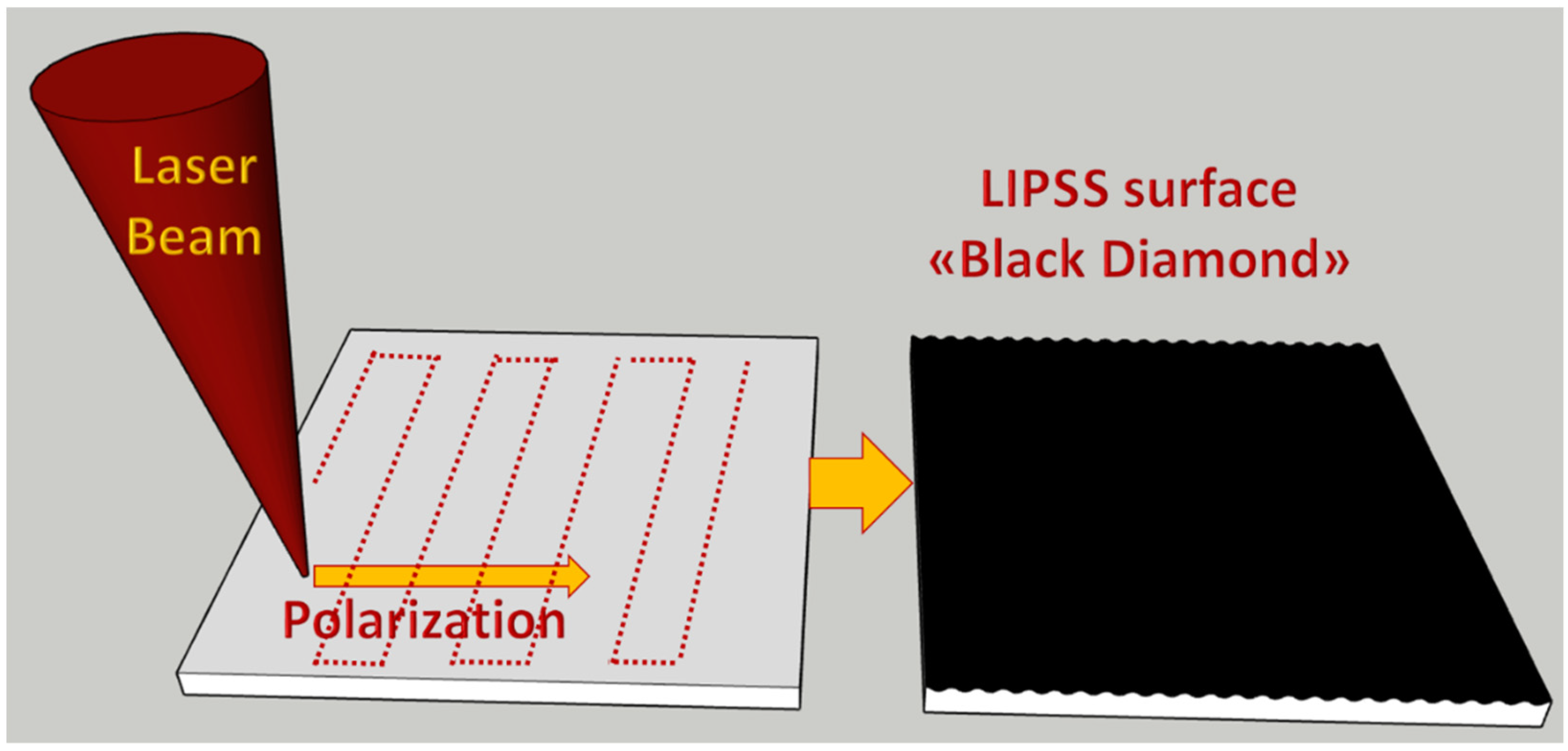
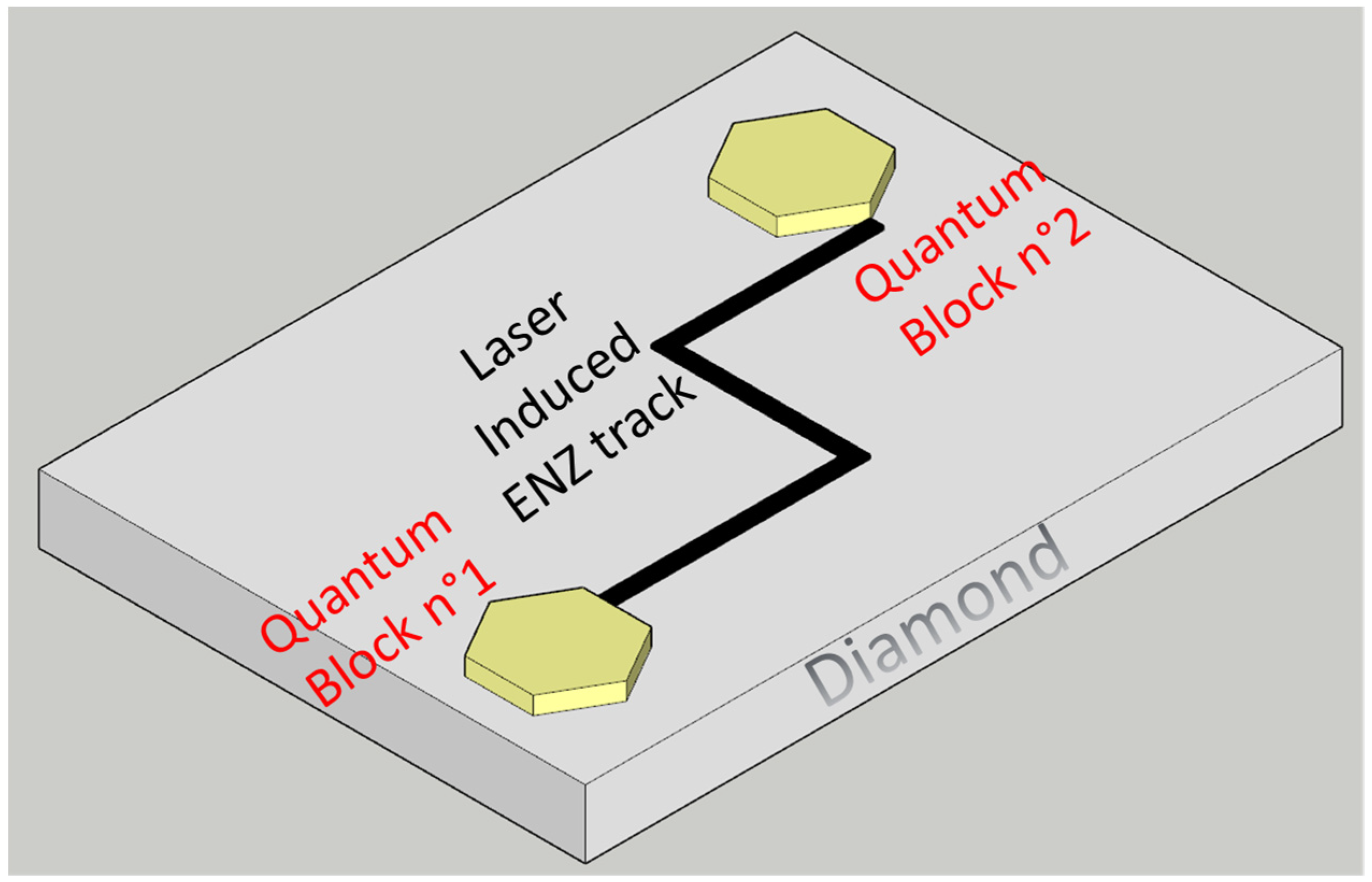


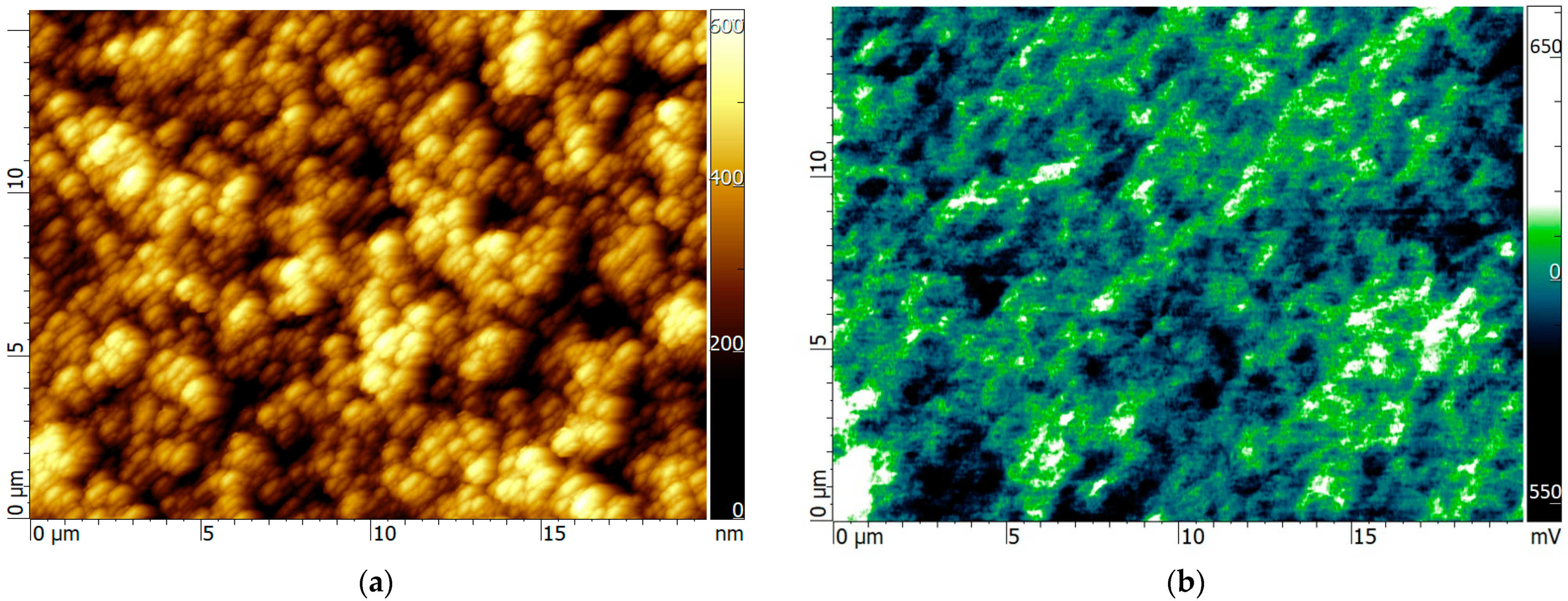
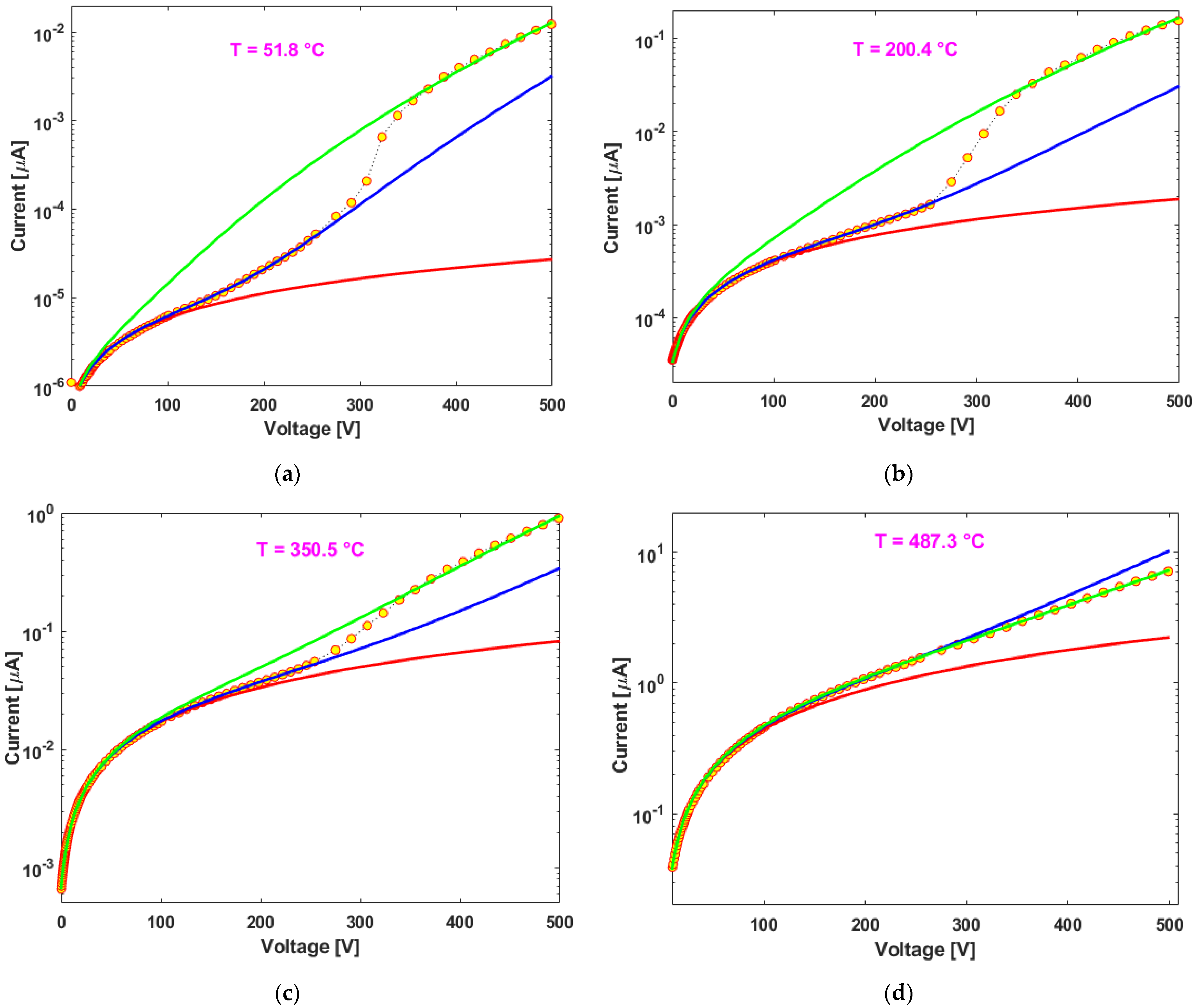
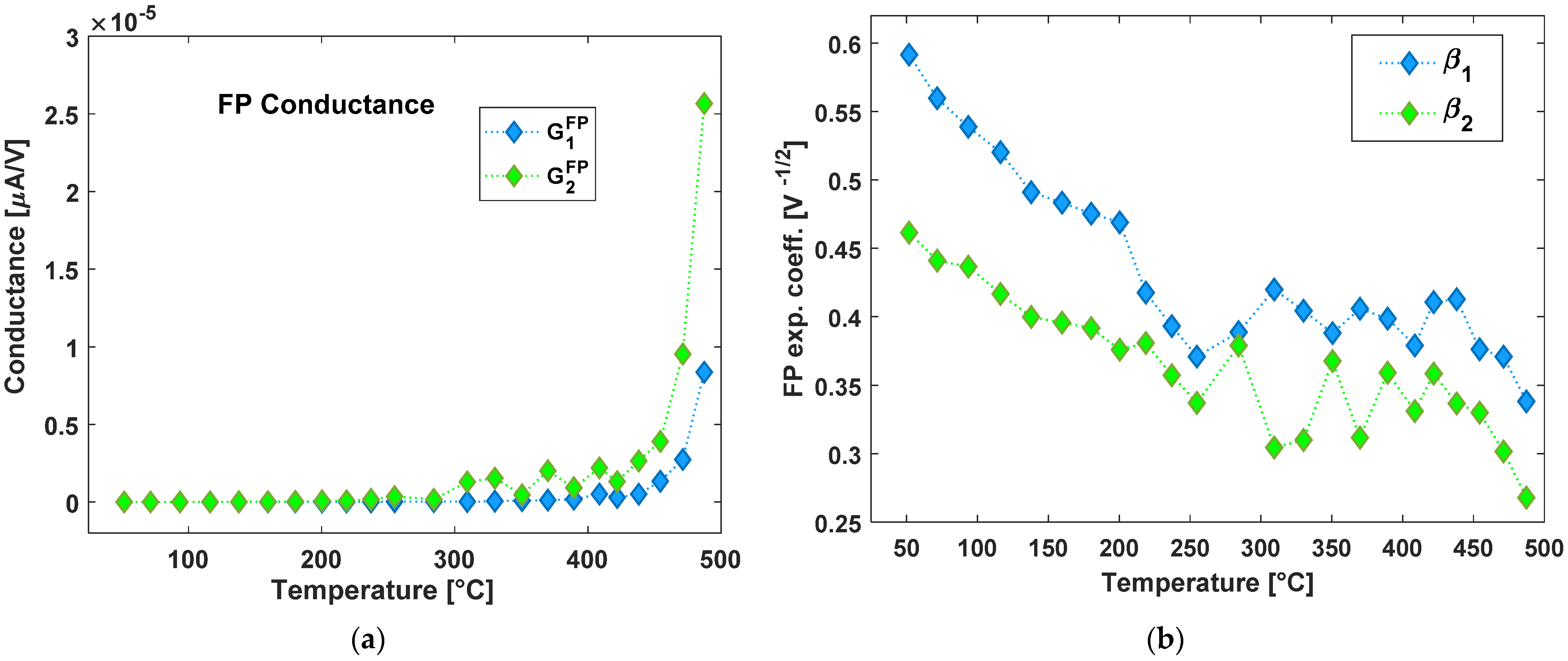
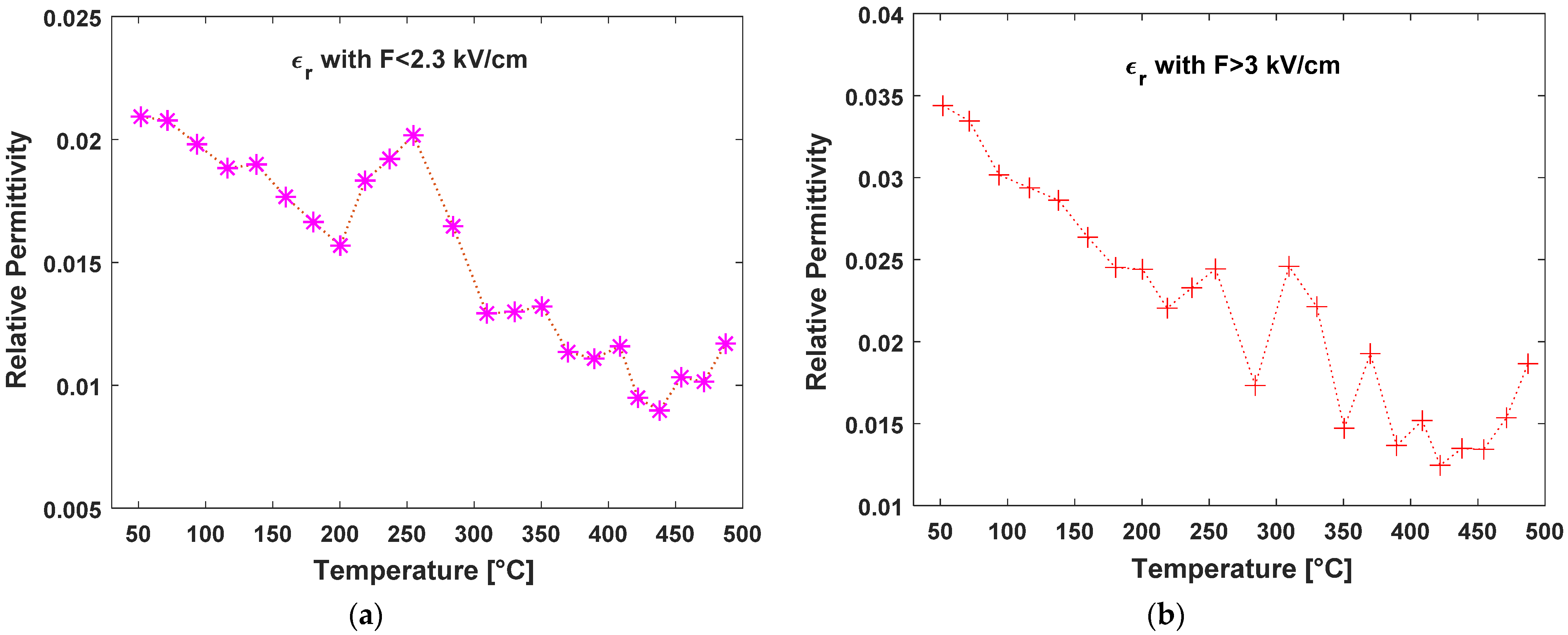
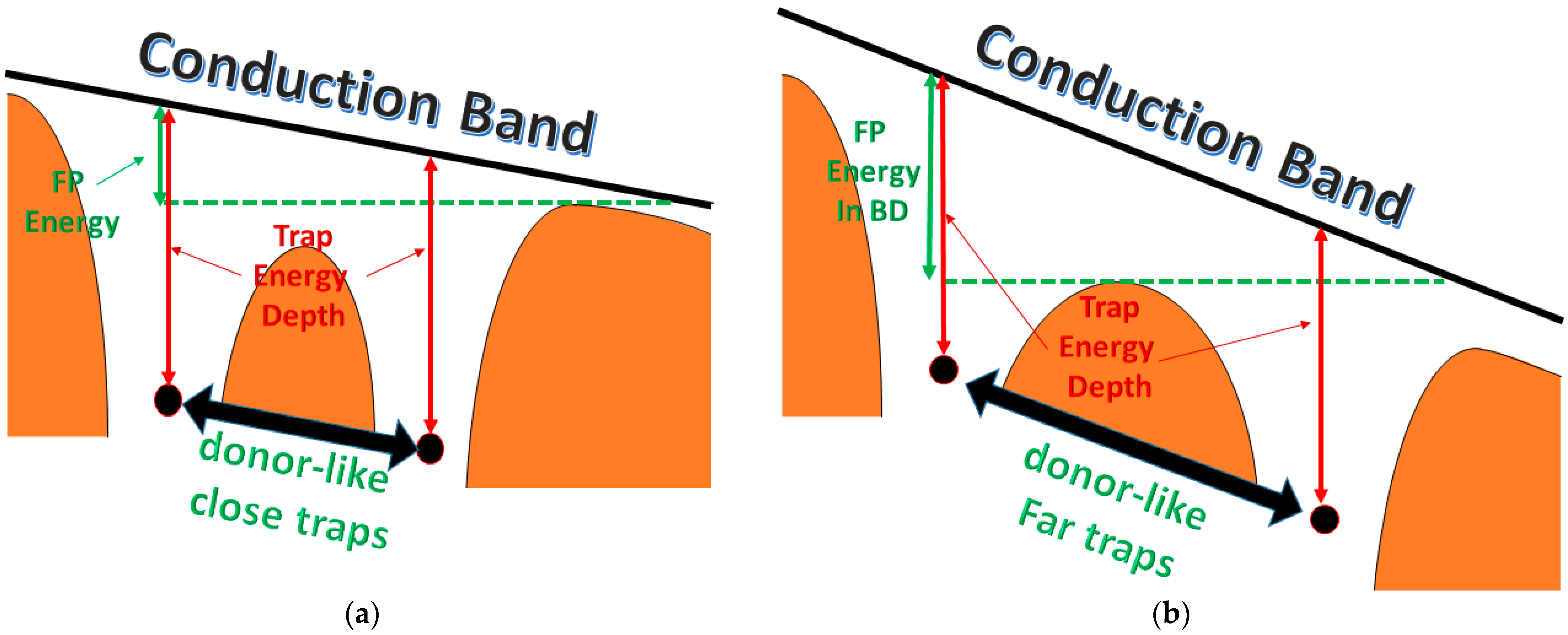
Disclaimer/Publisher’s Note: The statements, opinions and data contained in all publications are solely those of the individual author(s) and contributor(s) and not of MDPI and/or the editor(s). MDPI and/or the editor(s) disclaim responsibility for any injury to people or property resulting from any ideas, methods, instructions or products referred to in the content. |
© 2023 by the authors. Licensee MDPI, Basel, Switzerland. This article is an open access article distributed under the terms and conditions of the Creative Commons Attribution (CC BY) license (https://creativecommons.org/licenses/by/4.0/).
Share and Cite
Orsini, A.; Barettin, D.; Pettinato, S.; Salvatori, S.; Polini, R.; Rossi, M.C.; Bellucci, A.; Bolli, E.; Girolami, M.; Mastellone, M.; et al. Frenkel-Poole Mechanism Unveils Black Diamond as Quasi-Epsilon-Near-Zero Surface. Nanomaterials 2023, 13, 240. https://doi.org/10.3390/nano13020240
Orsini A, Barettin D, Pettinato S, Salvatori S, Polini R, Rossi MC, Bellucci A, Bolli E, Girolami M, Mastellone M, et al. Frenkel-Poole Mechanism Unveils Black Diamond as Quasi-Epsilon-Near-Zero Surface. Nanomaterials. 2023; 13(2):240. https://doi.org/10.3390/nano13020240
Chicago/Turabian StyleOrsini, Andrea, Daniele Barettin, Sara Pettinato, Stefano Salvatori, Riccardo Polini, Maria Cristina Rossi, Alessandro Bellucci, Eleonora Bolli, Marco Girolami, Matteo Mastellone, and et al. 2023. "Frenkel-Poole Mechanism Unveils Black Diamond as Quasi-Epsilon-Near-Zero Surface" Nanomaterials 13, no. 2: 240. https://doi.org/10.3390/nano13020240
APA StyleOrsini, A., Barettin, D., Pettinato, S., Salvatori, S., Polini, R., Rossi, M. C., Bellucci, A., Bolli, E., Girolami, M., Mastellone, M., Orlando, S., Serpente, V., Valentini, V., & Trucchi, D. M. (2023). Frenkel-Poole Mechanism Unveils Black Diamond as Quasi-Epsilon-Near-Zero Surface. Nanomaterials, 13(2), 240. https://doi.org/10.3390/nano13020240










